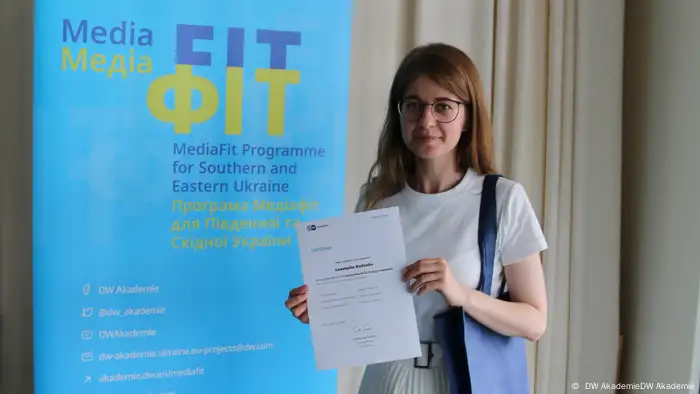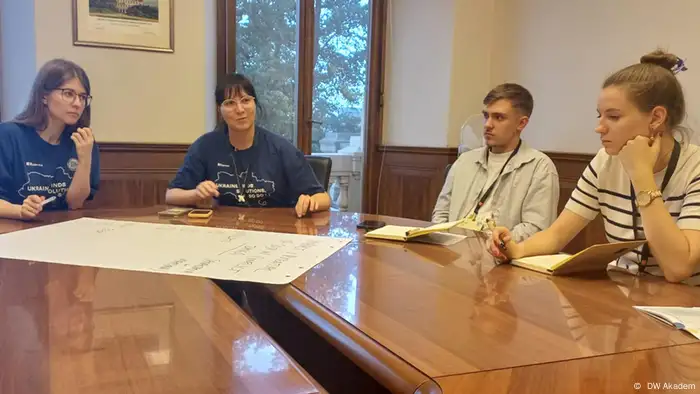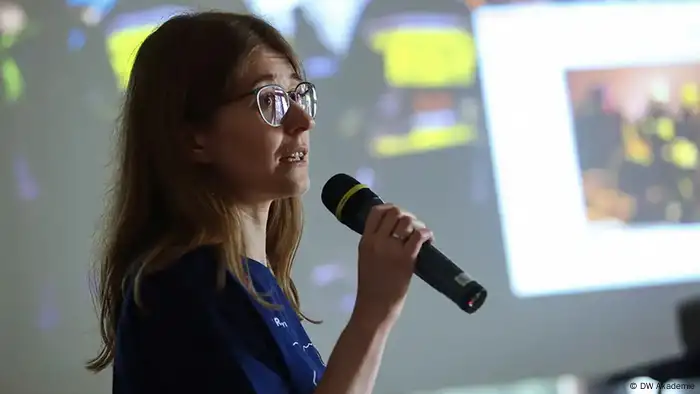Europe/Central Asia
In Ukraine, solutions journalism illuminates paths forward
After her hometown was invaded by Russian troops, Anastasiia Rudenko started using solutions journalism to empower Ukrainians.
When her hometown of Sloviansk was first occupied 10 years ago, a young political science major had to watch from afar in Kyiv.
"It was almost like a silent occupation," Anastasiia Rudenko reflected in a recent interview.
Her city was one of the first to be captured as part of the first Russian invasion into the eastern parts of Ukraine. Rudenko felt like she needed speak out about it. She quickly realized the importance of up-to-the-minute information and she and her sister began tweeting what scant reports they could get from their family and friends.
Little did she know that those first efforts to keep fellow citizens informed would lead her on a path to becoming a journalist and publisher of the largest independent outlet in eastern Ukraine.
To Rudenko, journalism has always been more than simply keeping up to date with the world. This is reflected in her commitment to solutions journalism – a type of reporting closely related to constructive journalism – that looks for the larger picture, focusing on both problems and their solutions.
Rebirth of consciousness
For Rudenko, solutions journalism can and should be a part of the practice of editorial teams, even during times of crisis.
In fact, her inspiration to use solutions journalism came about because of the occupation of her home city. Slovyansk, part of the Donetsk region, was eventually liberated by Ukrainian forces in 2014. And it was in that period after liberation that something seemed to change for both her and other residents.

Journalist and publisher with Eastern Variant, Anastasiia Rudenko attended a MediaFit event in Germany in 2023
"There was a rebirth of consciousness, a window of opportunity," Rudenko explained. "Before the occupation, it was a calm city with little happening. But afterwards, we understood the price of freedom and how important it is to be involved in your community."
She went on to found Rubryka in 2018, which ended up becoming the first solutions journalism outlet in Ukraine. Rudenko wanted to use that kind of momentum to look at her region and country differently, to learn from the work that had been done and successes that have been achieved.
And, after receiving training from the Solutions Journalism Network, she began pivoting the outlet in that direction.
"I realized it was the approach that Ukraine needs," she explained.
This is one of the reasons DW Akademie included support for solutions journalism in Ukraine as part of their new project MediaFit:ReLOADED.
"If solutions journalism in beneficial for any country, it is especially important for Ukrainians now," said DW Akademie’s Yana Naralska. "It reminds people to have hope in dire situations, while it empowers people to think what they can do to make their lives easier and safer."
Problems and solutions
Rudenko is quick to point out that solutions journalism is not the same thing as positive news. It does not focus on feel-good stories, rather solutions journalism looks at successes and answers to problems, instead of just the problems themselves. It also explores if solutions may be applicable to similar situations.
Solutions journalism is related to constructive journalism – an area of focus for DW – although they do differ in scope. Solutions journalism follows a story to its conclusion, showing both the problem and the outcome. Constructive journalism tends to have a wider lens that covers larger topics,such as climate change or homelessness, and can offer possible solutions, instead of only what has occurred.
Both types of journalistic reports can take longer to produce, as there can be more research and production work required. Rudenko believes it is well worth the effort and offers a way to fight back while working toward a better future.
"It is a very demanding approach, but it is also a promising approach," she said. "This war is against our spirit, our morale to fight."
Yet solutions journalism is not necessarily applicable for every situation. Rudenko has gone on to give workshops and trainings on solutions journalism, to sometimes mixed responses. Some newsrooms find it inspiring, others, such as those on the front lines, can find it difficult to apply to their current situation.

Anastasiia Rudenko (left) connected with other solutions journalism experts at the Solutions Journalism Summit in Czech Republic
Practical results
When solutions journalism is employed, Rudenko has seen some impressive results. Beyond her work with Rubryka, she is also the publisher of Eastern Variant, a large independent media outlet with a diverse readership. While most stories are not solutions-oriented, some of their most impactful have been.
One such story highlighted children with disabilities in Ukraine who have suffered acute trauma due to the war. The story then went on to explain an initiative pioneered by a group psychologists which has been successful in providing support. After the story was published, over two thousand families reached out to the initiative for help.
Another story reported on the struggle that soldiers faced during the winter months due to freezing conditions. The piece then went on to explain how local community leaders were able to organize supplies for those stationed in the area. After an English version of the story was published, a group in the United States began sending knitted pieces to keep the soldiers warm.
For Rudenko, these stories illuminate the power that journalism can have when the full story is told. She sees an intrinsic value in this approach and viewpoint, particularly when it comes to Ukraine and ten years of conflict.
"It is a very long war and it can be difficult to always believe in a happy ending, but solutions journalism can keep us hopeful while not being blind or falsely positive." Rudenko explained. "And it can show us how to embrace the imperfections in solutions."
Eastern Variant is a partner organization with MediaFit:ReLOADED, funded by the European Union.
DW recommends
- Date 05.11.2024
- Author Alex Bodine
- Feedback: Send us your feedback.
- Print Print this page
- Permalink https://p.dw.com/p/4mero
- Date 05.11.2024
- Author Alex Bodine
- Send us your feedback.
- Print Print this page
- Permalink https://p.dw.com/p/4mero

